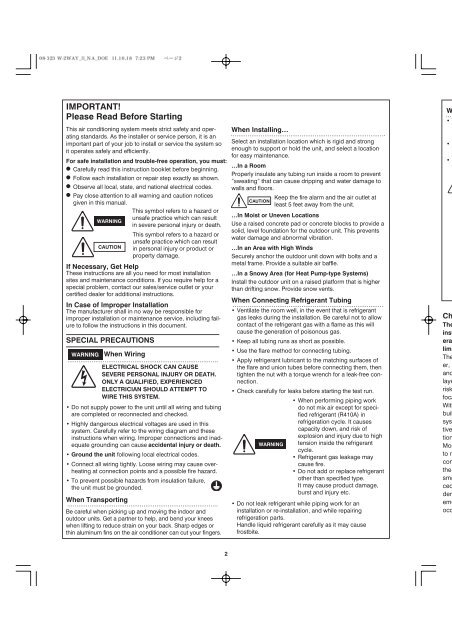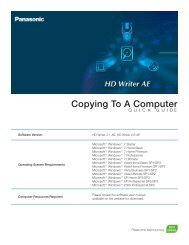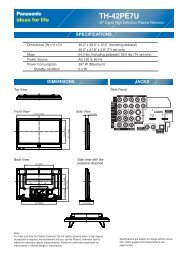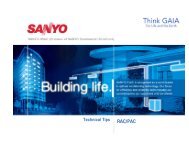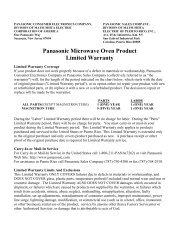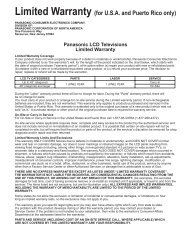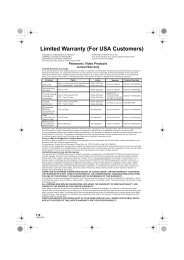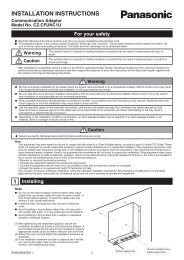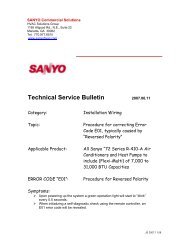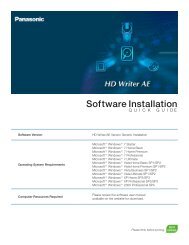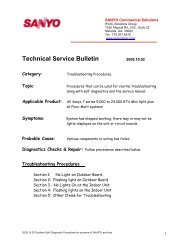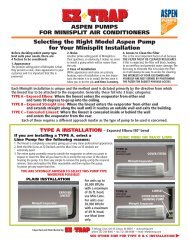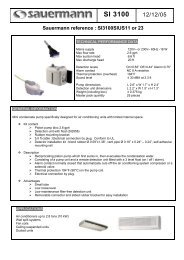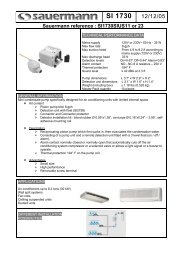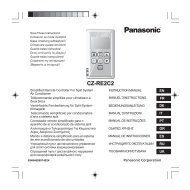ECOi 2 Way Installation Manual - Panasonic
ECOi 2 Way Installation Manual - Panasonic
ECOi 2 Way Installation Manual - Panasonic
You also want an ePaper? Increase the reach of your titles
YUMPU automatically turns print PDFs into web optimized ePapers that Google loves.
IMPORTANT!<br />
Please Read Before Starting<br />
This air conditioning system meets strict safety and operating<br />
standards. As the installer or service person, it is an<br />
important part of your job to install or service the system so<br />
it operates safely and efficiently.<br />
For safe installation and trouble-free operation, you must:<br />
Carefully read this instruction booklet before beginning.<br />
Follow each installation or repair step exactly as shown.<br />
Observe all local, state, and national electrical codes.<br />
Pay close attention to all warning and caution notices<br />
given in this manual.<br />
This symbol refers to a hazard or<br />
unsafe practice which can result<br />
WARNING<br />
in severe personal injury or death.<br />
This symbol refers to a hazard or<br />
unsafe practice which can result<br />
CAUTION in personal injury or product or<br />
property damage.<br />
If Necessary, Get Help<br />
These instructions are all you need for most installation<br />
sites and maintenance conditions. If you require help for a<br />
special problem, contact our sales/service outlet or your<br />
certified dealer for additional instructions.<br />
In Case of Improper <strong>Installation</strong><br />
The manufacturer shall in no way be responsible for<br />
improper installation or maintenance service, including failure<br />
to follow the instructions in this document.<br />
SPECIAL PRECAUTIONS<br />
WARNING When Wiring<br />
ELECTRICAL SHOCK CAN CAUSE<br />
SEVERE PERSONAL INJURY OR DEATH.<br />
ONLY A QUALIFIED, EXPERIENCED<br />
ELECTRICIAN SHOULD ATTEMPT TO<br />
WIRE THIS SYSTEM.<br />
Do not supply power to the unit until all wiring and tubing<br />
are completed or reconnected and checked.<br />
Highly dangerous electrical voltages are used in this<br />
system. Carefully refer to the wiring diagram and these<br />
instructions when wiring. Improper connections and inadequate<br />
grounding can cause accidental injury or death.<br />
Ground the unit following local electrical codes.<br />
Connect all wiring tightly. Loose wiring may cause overheating<br />
at connection points and a possible fire hazard.<br />
To prevent possible hazards from insulation failure,<br />
the unit must be grounded.<br />
When Transporting<br />
Be careful when picking up and moving the indoor and<br />
outdoor units. Get a partner to help, and bend your knees<br />
when lifting to reduce strain on your back. Sharp edges or<br />
thin aluminum fins on the air conditioner can cut your fingers.<br />
2<br />
When Installing…<br />
Select an installation location which is rigid and strong<br />
enough to support or hold the unit, and select a location<br />
for easy maintenance.<br />
…In a Room<br />
Properly insulate any tubing run inside a room to prevent<br />
“sweating” that can cause dripping and water damage to<br />
walls and floors.<br />
CAUTION<br />
When Connecting Refrigerant Tubing<br />
WARNING<br />
Keep the fire alarm and the air outlet at<br />
least 5 feet away from the unit.<br />
…In Moist or Uneven Locations<br />
Use a raised concrete pad or concrete blocks to provide a<br />
solid, level foundation for the outdoor unit. This prevents<br />
water damage and abnormal vibration.<br />
…In an Area with High Winds<br />
Securely anchor the outdoor unit down with bolts and a<br />
metal frame. Provide a suitable air baffle.<br />
…In a Snowy Area (for Heat Pump-type Systems)<br />
Install the outdoor unit on a raised platform that is higher<br />
than drifting snow. Provide snow vents.<br />
Ventilate the room well, in the event that is refrigerant<br />
gas leaks during the installation. Be careful not to allow<br />
contact of the refrigerant gas with a flame as this will<br />
cause the generation of poisonous gas.<br />
Keep all tubing runs as short as possible.<br />
Use the flare method for connecting tubing.<br />
Apply refrigerant lubricant to the matching surfaces of<br />
the flare and union tubes before connecting them, then<br />
tighten the nut with a torque wrench for a leak-free connection.<br />
Check carefully for leaks before starting the test run.<br />
When performing piping work<br />
do not mix air except for specified<br />
refrigerant (R410A) in<br />
refrigeration cycle. It causes<br />
capacity down, and risk of<br />
explosion and injury due to high<br />
tension inside the refrigerant<br />
cycle.<br />
Refrigerant gas leakage may<br />
cause fire.<br />
Do not add or replace refrigerant<br />
other than specified type.<br />
It may cause product damage,<br />
burst and injury etc.<br />
Do not leak refrigerant while piping work for an<br />
installation or re-installation, and while repairing<br />
refrigeration parts.<br />
Handle liquid refrigerant carefully as it may cause<br />
frostbite.<br />
W<br />
T<br />
C<br />
t<br />
Ch<br />
The<br />
inst<br />
era<br />
limi<br />
The<br />
er, i<br />
and<br />
laye<br />
risk<br />
foca<br />
With<br />
buil<br />
sys<br />
tive<br />
tion<br />
Mos<br />
to r<br />
con<br />
the<br />
sma<br />
ced<br />
den<br />
eme<br />
occ


